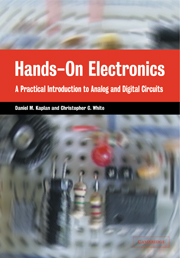Book contents
- Frontmatter
- Contents
- List of figures
- List of tables
- About the authors
- To the Reader
- Acknowledgments
- Introduction
- 1 Equipment familiarization: multimeter, breadboard, and oscilloscope
- 2 RC circuits
- 3 Diodes
- 4 Bipolar transistors
- 5 Transistors II: FETs
- 6 Transistors III: differential amplifier
- 7 Introduction to operational amplifiers
- 8 More op amp applications
- 9 Comparators and oscillators
- 10 Combinational logic
- 11 Flip-flops: saving a logic state
- 12 Monostables, counters, multiplexers, and RAM
- 13 Digital↔analog conversion
- Further reading
- Appendix A Equipment and supplies
- Appendix B Common abbreviations and circuit symbols
- Appendix C RC circuits: frequency-domain analysis
- Appendix D Pinouts
- Glossary of basic electrical and electronic terms
- Index
11 - Flip-flops: saving a logic state
Published online by Cambridge University Press: 06 July 2010
- Frontmatter
- Contents
- List of figures
- List of tables
- About the authors
- To the Reader
- Acknowledgments
- Introduction
- 1 Equipment familiarization: multimeter, breadboard, and oscilloscope
- 2 RC circuits
- 3 Diodes
- 4 Bipolar transistors
- 5 Transistors II: FETs
- 6 Transistors III: differential amplifier
- 7 Introduction to operational amplifiers
- 8 More op amp applications
- 9 Comparators and oscillators
- 10 Combinational logic
- 11 Flip-flops: saving a logic state
- 12 Monostables, counters, multiplexers, and RAM
- 13 Digital↔analog conversion
- Further reading
- Appendix A Equipment and supplies
- Appendix B Common abbreviations and circuit symbols
- Appendix C RC circuits: frequency-domain analysis
- Appendix D Pinouts
- Glossary of basic electrical and electronic terms
- Index
Summary
Next we turn to flip-flops. Also known grandiosely as bistable multivibrators, these devices can remember their past. Their behavior thus depends not only on their present input but also on their internal state. Circuits containing flip-flops are termed sequential logic circuits, since their state depends on the sequence of inputs that is presented to them. A truth table is not sufficient to describe the operation of a sequential circuit – you need a timing diagram.
One category of sequential-logic circuits is the finite-state machine, which goes through a predetermined sequence of states, advancing to the next state each time it receives a clock pulse. We will encounter some examples of state machines in this chapter, including divide-by-two and divide-by-four counters. A useful tool in understanding a state machine is a state diagram, showing the sequence of states through which the circuit passes.
Some of these circuits will probably be the most complicated you have wired up so far. Prepare carefully in advance and you will find you can complete these exercises easily; if you are unprepared, it is likely to take you three to four times as long!
Apparatus required
The ideas explored in the following exercises apply equally whether CMOS or TTL gates are used – use whichever is most convenient. You will need a quad NAND (7400), a dual D-type flip-flop (7474), and a dual JK flip-flop (74112). In addition, you will need a 74373, a breadboard, two 1 k 14 W resistors, and a two-channel oscilloscope with two attenuating probes. (If possible, avoid unnecessary complications by not mixing CMOS and TTL chips within a single circuit.)
- Type
- Chapter
- Information
- Hands-On ElectronicsA Practical Introduction to Analog and Digital Circuits, pp. 143 - 154Publisher: Cambridge University PressPrint publication year: 2003

